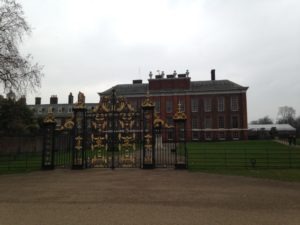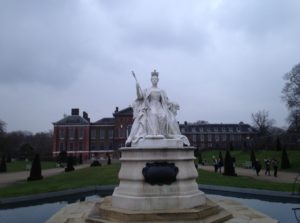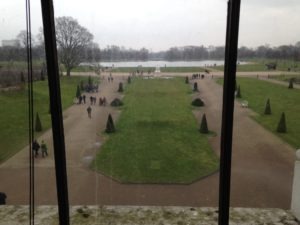In the 19th century, London was terrorized by what some believed to be a supernatural or demonic entity. There were numerous sightings and attacks around the city and even beyond. Although descriptions varied at times, the entity’s ability to jump great distances earned it the name Spring-heeled Jack. Who or what was this monstrous assailant?
A major source for this post is a lengthy article from 1884 entitled, “Spring-Heeled Jack,” published in the journal, All the Year Round. It gives a thorough review of the major events and claims surrounding the phenomenon from a Victorian era perspective. Any quotes I provide in this post are from this source.
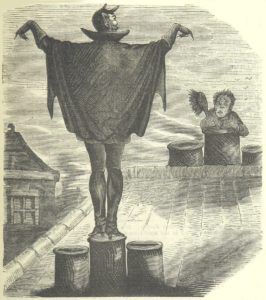
Image from Spring Heel’d Jack: The Terror of London (Source: British Library Flickr)
According to All the Year Round, the very first appearance of the entity that would become known as Spring-heeled Jack happened in the Barnes district of London in 1837. It was described as being “in the shape of a large white bull, attacking several persons, more particularly women, many of whom suffered most severely from fright.” From this starting point, sightings spread to numerous other London boroughs. Interestingly, the appearance of this specter sometimes differed dramatically between reports:
- East Sheen: “a white bear”
- Hampton: “clad in armor of brass, with spring shoes, and large claw-like gloves … scaled the walls of Bushey Park”
- Isleworth: “polished steel armor, with red shoes, etc.”
- Ealing: “steel armor”
- Hammersmith: “an immense baboon, six feet high, with enormous eyes, and arms of an extensive length … grunted like a hyena”
- John’s Wood: “sometimes appearing as a bear, and sometimes clad in mail”
- Forest Hill: “a figure clad in a bear’s skin, which upon being drawn aside, exhibited the human body, with long horns … clad in a suit of mail”
- Paddington Green: “figured clad in white … this matter-of-fact apparition jumped into a cabriolet [carriage].”
- Dulwich: “figure enveloped in a white sheet and blue fire”
- Blackheath: “Monstrous figure … had a phosphoric lustre … tremendous long ears, horns and tail like those of a bullock … threw itself over his [police officer’s] head … hooks, or springs, on his heels were distinctly visible”
- Holloway: “guise of a bear”
- Hackney: “in the shape of a lamp-lighter walking on his head and hands, and carrying his ladder between his feet, to which was suspended a lantern of large dimensions, amply lighted … somersaulted so high”
- Woolwich: “a blue flame issued from his mouth … dress on this occasion is described as that of a gentleman … wide strip of scarlet down the back of his coat … sprang over the fences”
- Dartford: “clad in a bearskin … putting out the town gas and leaving the streets in darkness”
- Primrose Hill: “figure of a man, in a flame of pale blue; it then assumed the bulk of a massive elephant, then of a windmill in full operation … became a large ball of snow, which rolled down the hill, and escaped further notice”
The descriptions seem to mainly fall into two types: animal and humanoid. Given that a white bear is quite different than a person clad in armor, I’m a little surprised that people assumed this was all the same phenomenon. From the beginning, it would seem there was an assumption that Jack could change his shape or perhaps had various costumes. The Forest Hill account resolves both variations into a humanoid figure wearing animal skin. Of course, as Spring-heeled Jack gained notoriety, some stories delved into the utterly fantastic, such as the Primrose Hill account.
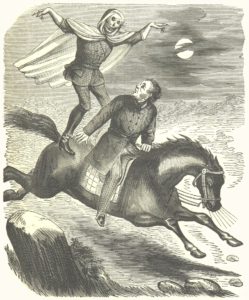
Image from Spring Heel’d Jack: The Terror of London (Source: British Library Flickr)
Reports indicated that Spring-heeled Jack’s activities were malicious in nature and they ranged in severity. Some cases simply talk about people being severely frightened, so it’s not clear if anything happened beyond simply seeing Jack. Other instances talk about physical attacks. For example, a number of people claimed that they were injured by his claws. Apparently one contemporary writer asserted that several people had actually died of fright. To escape pursuit, Jack was known to easily scale tall walls, hence his name.
It seems that there was no shortage of reports concerning sightings and attacks made by Spring-heeled Jack. In 1838, two detailed accounts emerged that ended up gaining prominence and tend to still be discussed today. As such, I’ll review both of those here. Additionally, I’ll explore events surrounding a particular area of London that I have a personal fondness for.
Jane Alsop Attack
On the evening of February 21, 1838, a young woman named Jane Alsop experienced a violent attack in front of her parent’s house where she lived. The house was situated on Bear-bind Lane, which was in an isolated location between the London boroughs of Bow and Old Ford.
At approx. 8:45 pm, Jane heard a ringing at the front gate. When she went to the door, she saw a man outside who identified himself as a police officer. He asked her to bring him a light as they had caught Spring-heeled Jack in the lane. She retrieved a lit candle and exited the house to give it to him. Upon taking the candle, he threw off a large cloak he was wearing and held the light to his chest. The man appeared to be wearing a helmet and a tight, white oilskin (raincoat). He then “vomited forth a quantity of blue and white flame from his mouth, his eyes resembling red balls of fire.” He lunged forth, grabbing Jane and tearing at her cloths with metallic claws. Screaming, Jane was able to break free and darted towards the house. However, the attacker caught up with her at the doorstep, injuring her neck and arms with his claws as well as tearing out some of her hair.
One of Jane’s sisters heard the noise and was able to get her inside, away from the assailant. He then kept knocking on the door and ringing the gate bell. The sister called for the police from an upstairs window and this caused him to retreat. He apparently left his cloak at the scene but an unknown person took it. Jane and her sisters were later taken by their father to the Lambeth Street police court to report the crime, with all of them corroborating Jane’s account.

Image from Spring Heel’d Jack: The Terror of London (Source: British Library Flickr)
Lucy Scales Attack
On March 7, 1838, at approx. 8:30 pm, 18-year-old Lucy Scales and her sister were walking home from their brother’s house located at Narrow Street, Limehouse. As they passed through Green Dragon Alley, they encountered a figure standing at an angle, wrapped in a cloak. As they came near, with Lucy leading the way, the person “spirted a quantity of blue flame right in her face.” Lucy was temporarily blinded and fell to the ground. According to her sister, the attacker was “tall, thin, and of gentlemanly appearance, and carried in front of him a small lamp, similar to those used by the police.” After breathing out the flame, he said nothing and simply walked away. Their brother heard Lucy’s screaming and ran to the scene, finding Lucy on the ground being supported by her sister. The next day, Lucy and her brother reported the incident to the Lambeth Street police office.
Kensington Sightings
I’ve spent a little time in the London district of Kensington. It’s a bustling area that is famously home to Kensington Palace, a royal residence. I was interested to learn that there were some Spring-heeled Jack sightings there in the 19th century. One report stated, “Even the royal precincts of Kensington Palace did not escape from his visits, children having seen the unearthly being dancing by moonlight on the Palace Green, and ever and anon scaling the walls of the royal forcing-houses [greenhouses].” Having been to the palace, it’s interesting to think of this mysterious character dramatically leaping about the area.
Another report set in Kensington has Jack making an evening appearance in the vicinity of Lord Holland’s gate. “A gaunt figure, accoutered like Don Quixote, and covered with spikes, was seen striding along the road, and, after staring in the faces of some laboring men, disappeared in an instant.” Afterwards, the men go to a tavern to share their story. They then decide to return to the same spot in the hopes of seeing Jack again. However, instead of the original Don Quixote-like figure, they see “an uncouth monster, having the shape of an enormous baboon, playing its antics beneath some trees which overhung the road.” When the men get near, the creature jumps up onto the branches and vanishes. I find this case especially interesting as the same group of witnesses saw both the humanoid and animal versions of Jack. It’s also another case where the animal is described as a baboon.
Explanation
So, who or what was Spring-heeled Jack? A definitive, all-encompassing answer was never arrived at. Below are some of the hypothesis as well as some specific arrests:
- A Supernatural Entity – It’s clear that some people believed that Spring Heeled Jack was a supernatural entity, like a ghost or demon, with abilities that defied rational explanation.
- The Marquess of Waterford – There was a popular rumor that Spring Heeled Jack was actually the Marquis of Waterford. Apparently Lord Waterford had a reputation for wild antics. However, as the 1884 article states, there was never a “shadow of proof” to support this claim. Still, it must have been widely believed, as an 1898 article in Harper’s specifically identifies the marquess as Spring-heeled Jack.
- A High Society Conspiracy – There was a rumor that the assaults were being perpetrated by a group of upper class individuals. Their motive being a £3,000 bet that they could cause the deaths of at least 30 people. This allegation was reported to a committee formed by the Lord Mayor.
- Two Craftsmen Arrested – In Bow Fields Fair, workers almost captured Spring Heeled Jack, but he escaped due to his intimate knowledge of the area. The police arrested two men, a master-bricklayer and a carpenter, in connection with the incident. After a long investigation, the men were released. Although the police believed that neither man was the assailant, they did feel the men were withholding information.
- Footman Fined – In Kilburn, a young footman went out “disguised as a ghost, in a white sheet and hideous mask, from which depended a long beard.” This man was apprehended and fined £4.
- Captain Fined – In 1848, Spring-heeled Jack terrorized a number of women in Devon. Eventually charges were brought against Captain Finch, a 60-year-old former soldier who was allegedly in poor health. The accusation was shocking as Finch was well respected and perceived as a gentleman. His accuser was a young woman employed as a servant in the area. She asserted that she had been assaulted twice that past January by someone in a fur coat, horns, and a mask. The magistrate ended up finding Capt. Finch guilty and fined him 34 shillings.
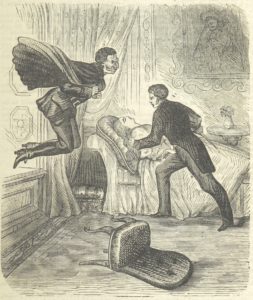
Image from Spring Heel’d Jack: The Terror of London (Source: British Library Flickr)
When one looks at the Spring-heeled Jack accounts en masse, it’s likely there’s a mixture of truth, embellishment, and all out fabrication. Of course, determining where those lines fall can be tricky. Some elements, while shocking, are plausible. There could have been a person (or multiple people) wearing elaborate costumes (armor, animal skin, metal gloves) that was traveling around terrorizing the public. The notoriety of the whole affair likely inspired some spring-heeled imitators.
Even some of the more fantastic details could be based on truth. Consider the fire breathing in the Alsop and Scales accounts. The police of the time thought that Jack could be blowing a combustible liquid out through a tube. It’s interesting to note that, in both cases, a flame was present in front of Jack beforehand. For the Alsop case, Jane handed him a candle, while in the Scales case, Jack was carrying a lantern. It could be that the perpetrator was using some kind of fire-breathing technique.
The tales of the Jacks’ great leaps could be embellished. Perhaps the assailant was quite agile and made some impressive jumps or climbs. With the shock of the encounter and numerous retellings, it could be that the feats got exaggerated. Of course, transforming into an elephant, windmill, and snowball seems much more in the realm of fiction.
It’s entirely possible that an element of hysteria propelled the Spring-heeled Jack phenomenon. While some of the accounts were certainly verified, others couldn’t be. Interestingly, when reporters and police tried to investigate some of the Spring-heeled Jack stories, the people who were supposedly involved denied any first-hand knowledge.
As mentioned above, it does appear that some segment of the population believed Jack to be otherworldly. However, with the pressure put on police to find a culprit and the sentiments of the period articles I read, it would seem that many people thought Spring-heeled Jack was a human menace.
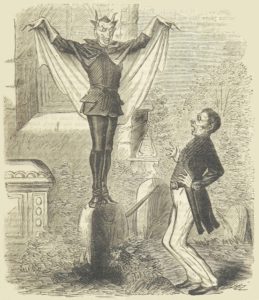
Image from Spring Heel’d Jack: The Terror of London (Source: British Library Flickr)
Aftermath
According to the All the Year Round article, the sightings of Spring-heeled Jack dried up after April 1838. However, other sources indicate that Jack may have just changed locations. As mentioned above, the Capt. Finch incident occurred in 1848. In the 1850s-60s, there were sightings in the Midlands, and there was an encounter in Lincoln in 1870. The last sighting supposedly took place in Liverpool in 1904.
The whole Spring-heeled Jack affair captured the attention of the Victorian public. As demonstrated in some of this post’s pictures, even penny dreadfuls came out featuring Jack as the title character. Unfortunately, although theories abound, answers are slim. Ultimately, it seems that we may never have the full story on this mysterious phantom.
Sources
Brewer, Ebenezer Cobham. The Reader’s Handbook of Allusions, References, Plots and Stories: With Two Appendices. United Kingdom: Chatto and Windus, 1880. https://www.google.com/books/edition/The_Reader_s_Handbook_of_Allusions_Refer/9ZtOAQAAMAAJ.
“British and Foreign Gleanings.” The South Australian. July 27, 1847. https://trove.nla.gov.au/newspaper/article/71608928.
Castelow, Ellen. “Spring Heeled Jack.” Historic UK. https://www.historic-uk.com/CultureUK/Spring-Heeled-Jack/.
“The Ghost, Alias ‘Spring-heeled Jack,’ Again.” Annual Register. United Kingdom: n.p., 1839. https://www.google.com/books/edition/Annual_Register/j5FNfdZ8QwcC.
Mackley, J. S. (2016) Springheeled Jack: the Terror of London. Aeternum: the Journal of Contemporary Gothic Studies. 3(2), pp. 120. 23244895. http://nectar.northampton.ac.uk/9059/.
“Outrage on a Young Lady.” Annual Register. United Kingdom: n.p., 1839. https://www.google.com/books/edition/Annual_Register/j5FNfdZ8QwcC.
“Spring-heeled Jack.” All the Year Round. Vol. 35. United Kingdom: Charles Dickens, 1884. https://www.google.com/books/edition/All_the_Year_Round/ngHWAAAAMAAJ.
Written by A. P. Sylvia

